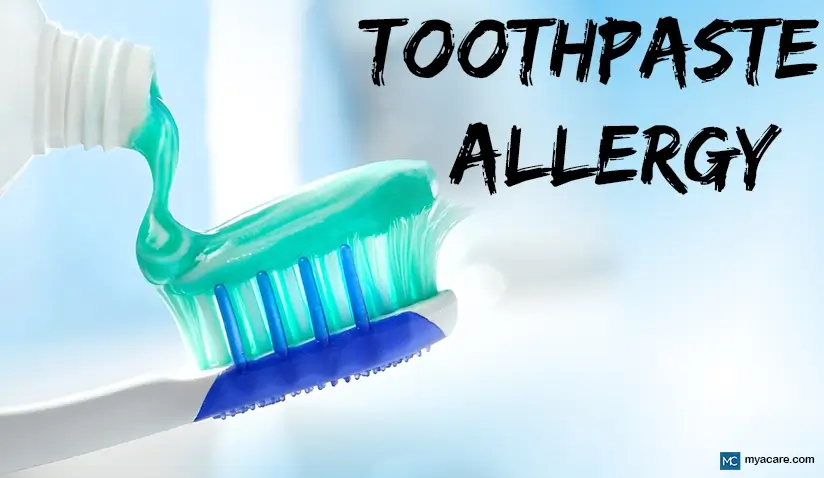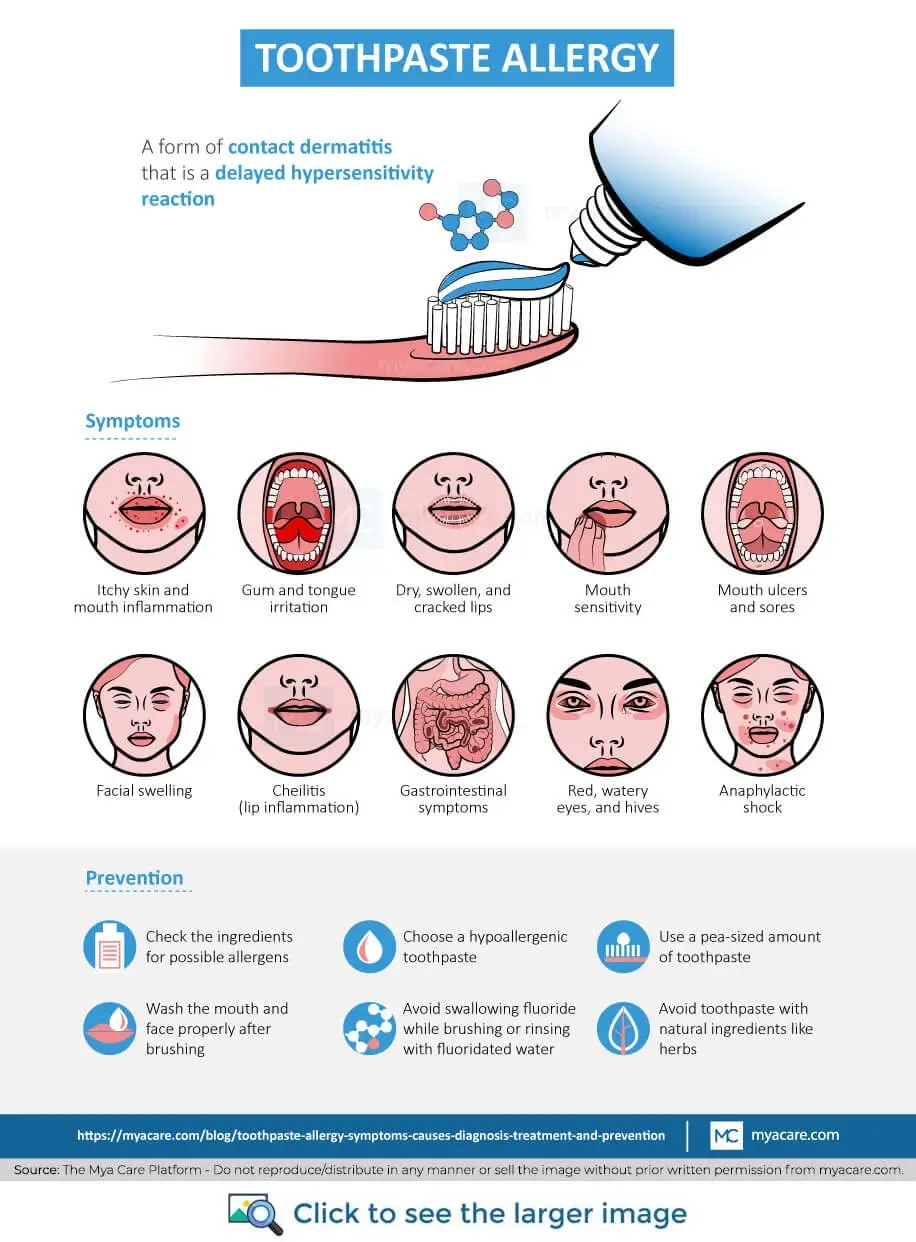Toothpaste Allergy: Symptoms, Causes, Diagnosis, Treatment, and Prevention

Updated 06 November 2023
Toothpastes (or dentifrices) are pastes or gels that are applied to teeth using a toothbrush to maintain oral hygiene. These are complex formulations comprising more than 20 ingredients. The chemical composition of toothpaste is constantly changing with scientific innovations and advancements. Research suggests that toothpastes contain several ingredients that may cause allergic reactions.
Allergic reactions to toothpaste are a form of contact dermatitis that can result in soreness, itching, ulceration, and cracked lips. Although this condition is reported in less than 1% of the population, it is imperative to know about it and the required course of action.
In this article, we will highlight the symptoms, causes, and precautions to be taken to avoid toothpaste allergies.
What is the composition of the toothpaste?
A toothpaste typically has the following components:
- Mild abrasives: Abrasives are used to remove debris and mild surface stains. E.g., Alumina, calcium pyrophosphate, and silica
- Anticaries agent: Anticaries agents help remineralize teeth and prevent caries. E.g., Sodium fluoride and Stannous fluoride.
- Humectants: Humectants prevent the loss of water from toothpaste. E.g., Erythritol, Sorbitol, Glycerine, Propylene glycol
- Surfactants (detergents): Surfactants are added to create foaming action. E.g., Sodium Lauryl Sulfate, Cocamidopropyl betaine
- Flavoring agents: Flavoring agents are added to mask the taste of surfactants and freshen the breath. E.g., cinnamon, lemon, and mint flavors (menthol, peppermint oil, spearmint oil)
- Sweeteners: Sweeteners are added to improve the taste of the toothpaste. E.g., Sucralose, Xylitol, Sodium saccharin
- Coloring agents: Coloring agents are added to improve the color of toothpaste. E.g., Titanium dioxide
- Water: Water acts as a vehicle and helps dissolve active inorganic ingredients.
- Preservatives: Parabens are most commonly used to increase the shelf life of toothpaste. E.g., Sodium benzoate, methyl/ethyl paraben
- Thickening agents: Some toothpaste manufacturers may add thickening agents to obtain the desired toothpaste consistency. E.g., Gluten
What are the most reported allergens in toothpaste?
Here are some of the potential allergens present in toothpaste that can cause allergy:
- Flavoring agents such as cinnamon, spearmint, or peppermint oils
- Preservatives such as Parabens (e.g., Sodium Benzoate, methyl/ethyl paraben)
- Surfactants such as Cocamidopropyl betaine and Sodium Lauryl Sulfate
- Humectant such as Propylene Glycol (e.g., PEG-8, PEG-12, and PEG-1450)
- Mild abrasives such as pyrophosphates
- Thickening agents such as Gluten
- Anti-caries agents such as Stannous fluoride, in rare cases
How do allergens cause toothpaste allergy?
Toothpaste allergy is a form of contact dermatitis that is a delayed hypersensitivity reaction. It develops after the oral mucosa (inner skin) comes into contact with allergens or haptens. A hapten is a molecule that can cause an immune reaction only when attached to proteins present on the mucosa or skin. Following sensitization, subsequent exposure to allergens beyond an individual’s threshold results in clinically visible symptoms of the disease.
In general, this reaction takes more than 12 hours to locally develop minimum signs of inflammation.
What are the symptoms associated with toothpaste allergies?
Toothpaste allergies can present with the following symptoms:
- Inflammation and itchy skin in and around the mouth
- Irritation in the gums and tongue
- Facial swelling
- Cheilitis, which causes the skin to crack at the corners of the mouth
- Dry, swollen, and cracked lips
- Painful ulcers and sores (canker sores) in the mouth
- Gastrointestinal symptoms, such as an upset stomach
- Red, watery eyes, and hives
- Sensitivity or a mild burning sensation in the mouth
- In rare cases, anaphylactic shock (a life-threatening allergic reaction that can develop immediately)

How can a toothpaste allergy be diagnosed?
It is crucial to correctly diagnose a toothpaste allergy as they are quite uncommon; they can often be mistaken for other skin problems, such as eczema, skin allergies, and bacterial/viral infections. An allergy/patch test can be performed by a doctor to rule out allergies to the toothpaste. This test involves the placement of different chemicals on an individual’s back, with the results interpreted at 48, 72, and 96 hours after placement. If an individual is allergic to chemicals, skin reactions, such as swelling, redness, or itching, may occur.
In addition, knowing the symptoms and correlating them with immediate brushing can aid in reporting and diagnosing the allergy to the concerned dentist.
What is the optimal treatment for toothpaste allergies?
Identifying and avoiding the use of chemicals that cause toothpaste allergies is the best way to treat this condition. In the case of mild symptoms, a dentist or physician may recommend topical steroid ointments or mouthwash. In severe cases, systemic steroids are recommended.
How can toothpaste allergies be prevented?
Some of the methods used to prevent toothpaste allergy are as follows.
- Wash the mouth and face properly along the corners of the mouth after brushing. Make sure that no toothpaste residue is left at the corners of the mouth.
- Use toothpaste that is free of multiple ingredients.
- Use different brands of toothpaste to determine which brand causes the least allergic reactions.
- Avoid swallowing while brushing with fluoridated toothpaste or rinsing the mouth with fluoridated water.
- Use a pea-sized amount of toothpaste for brushing, as the lesser the amount of toothpaste used, the lesser the exposure.
- Try buying hypoallergenic toothpaste (allergy-free toothpaste) from stores and pharmacies. Individuals can also use hypoallergenic toothpaste if they have a gluten allergy/intolerance.
- Avoid toothpaste with natural ingredients like herbs, which can cause allergies.
- Contact a dentist or physician in case of an emergency.
If an individual has an allergy to toothpaste, it is better to avoid the use of similar oral care products such as chewing gums and oral rinses.
Conclusion
Being aware of toothpaste allergies empowers you to make informed choices about oral care routines and toothpaste selections. By staying vigilant and informed, you can uphold your oral health while minimizing the potential risks associated with toothpaste allergies. Toothpaste contains several ingredients that may cause allergies, such as flavoring agents, preservatives, surfactants, humectants, mild abrasives, thickening agents, and anti-caries agents.
To prevent allergies, you can switch to hypoallergenic toothpaste and avoid toothpastes with natural ingredients like herbs that can cause allergies. Diagnosing toothpaste allergies can be difficult, since it is often mistaken for eczema, skin allergies, or bacterial/viral infections. The best way to treat this condition is to identify and avoid the use of chemicals that cause toothpaste allergies. If you suspect you are suffering from a toothpaste allergy, seeking professional guidance is a key step towards holistic well-being.
To search for the best dentists in India, Malaysia, Singapore, Spain, Thailand, Turkey, the UAE, UK and the USA, please use the Mya Care search engine.
To search for the best healthcare providers worldwide, please use the Mya Care search engine.

Dr. Shilpy Bhandari is an experienced dental surgeon, with specialization in periodontics and implantology. She received her graduate and postgraduate education from Rajiv Gandhi University of Health Sciences in India. Besides her private practice, she enjoys writing on medical topics. She is also interested in evidence-based academic writing and has published several articles in international journals.
References:
Featured Blogs



